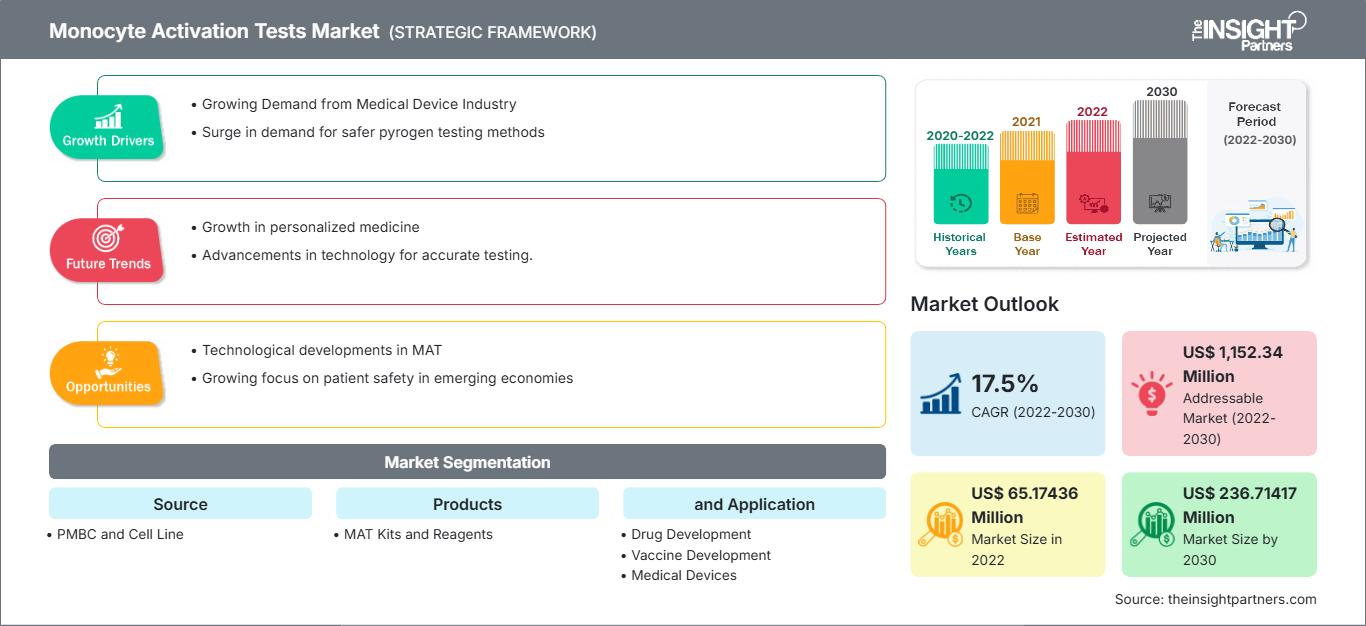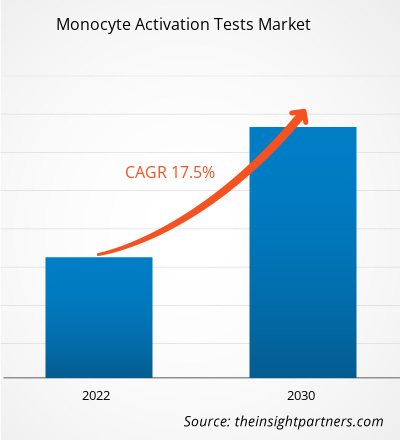[研究报告] 2022年,单核细胞活化测试市场规模为65,174.36万美元,预计到2030年将达到236,714.17万美元;预计2022年至2030年的复合年增长率为17.5%。
分析师观点
单核细胞活化测试市场分析包括对市场驱动因素的研究,例如患者安全问题的增加,以及制药、生物技术和医疗器械等终端用户行业对更安全的热原检测方法的需求激增。此外,预计单核细胞活化测试方法的技术发展将在预测期内推动单核细胞活化测试市场的增长。
根据来源,单核细胞活化测试市场分为PMBC和细胞系。 PMBC 部分在 2022 年占据了更大的份额,预计在预测期内将继续保持类似的趋势。基于产品,单核细胞活化测试市场分为 MAT 试剂盒和试剂。MAT 试剂盒部分在 2022 年占据了更大的份额,预计在预测期内将继续保持类似的趋势。另一方面,预计试剂部分在预测期内将录得更高的复合年增长率。基于应用,单核细胞活化测试市场细分为药物开发、疫苗开发、医疗器械和其他(研究等)。药物开发部分在 2022 年占据了最大的份额,预计在 2022 年至 2030 年期间将出现同样的趋势。
单核细胞活化测试检测由内毒素和非内毒素热原的协同作用导致的增强细胞因子释放。单核细胞活化试验 (MAT) 是一种体外检测方法,用于检测肠外给药、生物制剂和医疗器械中各类热原。过去五年中,最初采用单核细胞活化试验 (MAT) 检测的疫苗,都是此前使用兔热原试验作为释放检测方法的疫苗。此外,与 MAT 不同,细菌内毒素检测通常不适用于本质上具有热原性的产品,或含有疫苗中常用的添加剂(例如氢氧化铝)的产品,因为这些添加剂往往会干扰检测结果。MAT 在疫苗检测中的应用案例包括脑膜炎奈瑟菌疫苗、高免血清、脑膜炎球菌疫苗、黄热病疫苗、宋内志贺氏菌疫苗、狂犬病疫苗、乙肝疫苗和蜱传脑炎病毒疫苗。
自定义此报告以满足您的要求
您将免费获得任何报告的定制,包括本报告的部分内容,或国家级分析、Excel 数据包,以及为初创企业和大学提供超值优惠和折扣
单核细胞活化测试市场: 战略洞察

-
获取本报告的主要市场趋势。这个免费样本将包括数据分析,从市场趋势到估计和预测。
市场洞察
医疗器械行业需求不断增长
单核细胞活化试验 (MAT) 是一种基于人体细胞的试验,用于检测和量化细菌、真菌和病毒等热原。MAT 使用 ELISA 检测来测量处理过的血细胞中细胞因子的释放。MAT 广泛可用,但很少用于代替基于动物的热原试验来评估医疗器械的生物相容性。美国国家毒理学计划替代毒理学方法评估跨部门中心 (NICEATM) 和 PETA 国际科学联盟有限公司 (PISC) 于 2018 年 9 月在美国国立卫生研究院召开研讨会,阐述在医疗器械测试中实施 MAT 的必要步骤。据 DXC Technology Company 旗下的 Luxoft 称,医疗器械正通过预测算法和患者数据分析提供准确的诊断、有效的治疗和个性化护理,从而助力医疗保健的数字化转型。个性化医疗、植入式设备、智能医疗器械和非侵入性手术的技术进步正在彻底改变整个医疗保健行业,提供更好的护理、改善患者预后并降低成本。医疗器械行业的增长反过来又推动了单核细胞活化测试方法的发展,预计在预测期内仍将保持类似的趋势。
市场机遇
单核细胞活化测试方法的技术发展
单核细胞活化测试方法主要作为动物方法的替代方案引入,旨在提供在人体体外系统中进行热原测试的机会。单核细胞活化测试 (MAT) 在国际验证发布后于 2010 年被纳入欧洲药典 (EP)。市场参与者对 MAT 检测方法和试剂的不断创新和发展,从本质上提高了可重复性、灵敏度和特异性,从而使其成为检测热原的可靠且更安全的选择。MAT 检测方法用于检测肠外产品(例如药品和医疗器械)中的内毒素和非内毒素热原。通常,MAT 可根据监管指南提供传统动物测试的体外替代方案。兔热原测试和鲎试剂 (LAL) 测试广泛用于热原检测。这两种方法都使用动物,并显示出一些局限性。兔热原测试缺乏稳健性,因为动物反应可能与人类反应不同。此外,LAL 测试仅检测到内毒素,忽略了测试样本中可能存在的非内毒素热原,从而存在安全风险。因此,为了克服这些局限性,单核细胞活化试验 (MAT) 于 2010 年在欧洲药典中被引入,作为替代兔热原试验(欧洲药典第 2.6.30 章)的药典方法,并被美国食品药品监督管理局 (FDA) 列为行业指南。市场参与者不断创新和发展 MAT 检测方法和试剂,从而显著提高了重现性、灵敏度和特异性,使其成为检测热原的可靠且更安全的选择。
报告细分和范围
基于来源的洞察
根据来源,单核细胞活化试验市场分为 PMBC 和细胞系。PMBC 细分市场在 2022 年占据了更大的份额,预计在预测期内将继续保持类似的趋势。预计同一细分市场在2022年至2030年间的复合年增长率将更高。目前全球有两种商业化的单核细胞活化检测细胞来源——Mono-Mac-6 (MM6) 细胞系和外周血单核细胞 (PBMC)。MM6 源自单个急性单核细胞白血病患者的血液;因此,单核细胞有时缺乏能够反映持续检测致热原污染物并启动健康人体释放细胞因子所需的稳定表达的 TLR。因此,使用该细胞来源的 MAT 结果的可重复性较低。欧洲药典 (2.6.30) 也指出,基于 MM6 的 MAT 试剂盒检测非内毒素致热原的能力“有限”。另一方面,基于PBMC的MAT试剂盒的PBMC来源于经过筛选的健康捐献者的混合血液——这意味着,当与加标产品样本一起孵育时,单核细胞活化过程可以促进健康人体的生长。因此,基于此细胞来源的MAT试剂盒的结果始终被证实具有可重复性。欧洲药典(2.6.30)将此细胞来源视为能够高效检测内毒素和非内毒素热原。
目前市场上还有另外三家基于PBMC的商业化单核细胞活化检测供应商。每家供应商的检测限(LoD)分别为0.125 EU/ml、0.02 EU/ml和0.016 EU/ml。 CTL-MAT 检测拥有市场领先的检测限 (LoD),即 0.004 EU/ml,使其成为全球最灵敏的单核细胞活化检测。
基于产品的洞察
单核细胞活化检测市场按产品细分,可分为 MAT 试剂盒和试剂。MAT 试剂盒细分市场在 2022 年占据较大份额,预计在预测期内将继续保持类似的趋势。另一方面,试剂细分市场预计在预测期内将录得更高的复合年增长率。
基于应用的洞察
按应用细分,单核细胞活化检测市场可分为药物开发、疫苗开发、医疗器械和其他(研究等)。药物开发领域在 2022 年占据了最大的份额,预计在 2022 年至 2030 年期间将出现同样的趋势。根据美国国家医学图书馆的数据,药物是一类新兴的有机化合物,有助于提高患者的生活质量。制药行业涉及品牌药和仿制药的生产、开发和营销。2014 年,全球医药总收入首次超过 1 万亿美元。自 2017 年以来,医药市场一直以每年 5.8% 的速度扩张。同年,全球医药市场收入为 11,430 亿美元,2021 年达到 14,620 亿美元。单核细胞活化测试(MAT)旨在测试肠外药物、生物制剂和医疗器械中所有类别的热原。肠外给药的药品必须不含致热原(发热)污染,因为这些物质可能会诱发患者先天免疫系统发生危及生命的全身反应。这是为了确保生物制品在给患者给药前不含污染性的致热原物质。最初,RPT 和细菌内毒素检测 (BET)/鲎试剂 (LAL) 被用作体外实验。然而,动物试验方法的严格规定迫使市场参与者开发一种替代方法,以最大限度地减少此类动物试验方法的使用。考虑到 RPT 和 BET 的局限性以及复杂产品生产的增加,欧洲药典引入了 MAT 活化测试方法,该方法模拟人体免疫反应,并结合了 RPT(革兰氏阴性内毒素以外的致热原评估)和体外方法的优势。与RPT相比,MAT可以进行完全定量检测,无需使用动物,因此更适用于检测本身具有致热性且与生理相关的疫苗(因为这些疫苗使用人体细胞)。MAT检测方法能够检测血液衍生产品、细胞衍生产品、生物制剂和疫苗。MAT检测方法还可以检测各种药品和医疗器械,以及无法进行体内测试的产品(例如,含有透明质酸的产品)。近年来,这些因素促进了单核细胞活化测试市场的整体发展,预计在预测期内也将呈现类似的趋势。
单核细胞活化测试市场区域洞察
The Insight Partners 的分析师已详尽阐述了预测期内影响单核细胞活化测试市场的区域趋势和因素。本节还讨论了北美、欧洲、亚太地区、中东和非洲以及南美和中美洲的单核细胞活化测试市场细分和地域分布。
单核细胞活化测试市场报告范围
| 报告属性 | 细节 |
|---|---|
| 市场规模 2022 | US$ 65.17436 Million |
| 市场规模 2030 | US$ 236.71417 Million |
| 全球复合年增长率 (2022 - 2030) | 17.5% |
| 历史数据 | 2020-2022 |
| 预测期 | 2022-2030 |
| 涵盖的领域 |
By 来源
|
| 覆盖地区和国家 |
北美
|
| 市场领导者和主要公司简介 |
|
单核细胞活化测试市场参与者密度:了解其对业务动态的影响
单核细胞活化测试市场正在快速增长,这得益于终端用户需求的不断增长,而这些需求的驱动因素包括消费者偏好的演变、技术进步以及对产品优势的认知度的提升。随着需求的增长,企业正在扩展产品线,不断创新以满足消费者需求,并抓住新兴趋势,从而进一步推动市场增长。

- 获取 单核细胞活化测试市场 主要参与者概述
区域分析
根据地区,单核细胞活化测试市场细分为北美、欧洲、亚太地区、南美和中美以及中东和非洲。北美在 2022 年占据了最大的市场份额,预计在预测期内将继续保持类似的趋势,其次是欧洲。美国药典 (USP) 和加拿大政府等组织对单核细胞活化测试的监管实践进一步推动了该地区单核细胞活化测试市场的整体增长。此外,对患者安全问题的日益关注和医疗保健结果的改善也是促进北美市场增长的因素之一。
德国达姆施塔特的默克集团和/或其附属公司;Charles River Laboratories International, Inc.;赛默飞世尔科技;Sanquin;和龙沙集团是单核细胞活化检测市场的领先公司。
2023年10月,龙沙推出了两款新的快速单核细胞活化检测 (MAT) 系统:PyroCell MAT 快速系统和 PyroCell MAT 人血清 (HS) 快速系统,以简化和简化兔无热原检测。这些系统将取代龙沙传统的 MAT 系统试剂盒产品,新推出的产品包含全新的 PeliKine 人 IL-6 快速 ELISA 试剂盒,可最大限度地减少手动操作时间,并将结果获取时间从两天缩短至两小时。新的检测方法为制药和生物技术制造商提供了更简便的 MAT 检测选项,用于产品安全测试,同时有助于减少对动物的依赖。
- 历史分析(2 年)、基准年、预测(7 年)及复合年增长率
- PEST和SWOT分析
- 市场规模、价值/数量 - 全球、区域、国家
- 行业和竞争格局
- Excel 数据集
近期报告
客户评价
购买理由
- 明智的决策
- 了解市场动态
- 竞争分析
- 客户洞察
- 市场预测
- 风险规避
- 战略规划
- 投资论证
- 识别新兴市场
- 优化营销策略
- 提升运营效率
- 顺应监管趋势






















 获取免费样品 - 单核细胞活化测试市场
获取免费样品 - 单核细胞活化测试市场